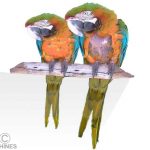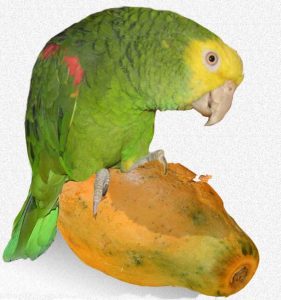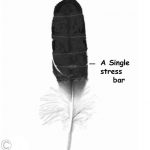 When Should I Take My Parrot To See A Veterinarian?
When Should I Take My Parrot To See A Veterinarian?
Ron Hines DVM PhD



Parrots Need To Be Examined By An Avian Veterinarian Whenever Their Apearance, Behavior Or Personality Changes For The Worse.
That is because most problems in pet birds can only be solved when they are caught and corrected soon after they begin. Unfortunately, most problems are presented late in a disease or health issue. By then, many cannot be solved or corrected.
Birds that we keep as pets retain many of their wild traits. Wildlife of all kinds need to disguise or mask early signs of disease. If they don’t do a good job of that they will be eaten by predators or abandoned by their flock. So just because your parrot appears healthy to you, it is no guarantee that problems are not brewing. Eighty percent of the health issues I see in parrots relate to how they are fed and housed. The infirmities of old age, accidents and infectious disease account for the rest – prety much in that order.
What Are Some Of The Warning Signs That I Should Look For?
Weight Loss
Change In Dropping Color Or Consistency
Discharges From the Eyes, Squinting Or Swelling
Discharges Or Changes In The Shape Or Diameter Of Its Nostrils
Sneezing
Lack Of Appetite Or Weight Loss
Less Activity In A Normally Active Bird
Carrying Its Wing(s) Drooped Below Its Body
Blood Anywhere In The Parrot’s Cage Or On Its Body
Open Mouth Breathing And Tail Bobbing (rhythmically going up and down)
Lumps Anywhere On The Parrot’s Body
Swollen Feet And/or Joints
Decrease In Your Parrots Grooming And Preening Activities
Decreased Talking, Calling and Singing
Sitting Apathetic Or Motionless On The floor Of Its Cage
Falling from Its Perch Or Limping Or Perching Or Favoring One Leg
Stress Bars Like This One Its Feathers:
Taking Your Pet To Your Veterinarian:
When you bring your bird to a veterinarian, your vet will begin by taking a detailed history from you. Your vet will wish to know where the bird was obtained. Imported birds (much rarer now, but still smuggled in) can have additional diseases to those that were domestically bred in North America. The vet will also ask you detailed question about the bird’s diet. (Be sure to bring some and be honest about how much of each your bird resceives and what remains in its dish the following morning!)
Birds on seed-based diets have a much higher incidence of nutritionally-based disease than those fed a pelleted diet. The vet will then examine the birds cage; perhaps while the technician weighs the bird. Birds of a single species tend to have very uniform weights. The cause of thinness or increased body weight should be explored. The technician will then prepare the bird’s stool for microscopic examination. Intestinal parasites, such as Giardia can cause weight loss, loose stools and feather picking. Next the veterinarian will examine the birds cage looking for evidence of abnormal stools, abnormal urine (the clear liquid portion of the stool) or toxic products within the birds grasp. The vet will check to see if perches are appropriate for your pet.
Unless the bird is exceptionally ill, the veterinarian will grasp and examine it. The vet will examine the eyes for evidence of intraoccular abnormalities infection or degenerative disease. He/She will examine the nares or nostrils and the surrounding cere for evidence of infection or vitamin deficiencies. The vet will listen with a stethoscope for the sounds of raspy respiration or fluid within the respiratory tree. He will examine the plumage carefully to look for evidence of external parasites, stress related feather abnormalities (stress bars), over grooming or viral plumage disease (PBFD). The vent or cloaca will be examined for signs of chronic diarrhea, papillomas or cloacal irritation. The vet will palpate the bird for evidence of superficial tumors and examine the abdominal area for evidence of increased intraabdominal pressure due to conditions such as egg-yolk peritonitis, liver enlargement or intraabdominal tumors.
Laboratory Tests That Might Be Indicated:
Because birds are such experts at masking the signs of disease, a yearly examination may also include laboratory testing of a sample of the bird’s blood. The cellular portion of the blood is examined to determine the number and nature of white cells present. Increased white cell count can be evidence of stress or infectious disease. Decreased number of red cells called anemia can be evidence of blood loss, metal toxicity or malnutrition. The liquid portion of the blood (serum) will be examined for evidence of liver, kidney, pancreatic or intestinal disease. The dark, granular portion of the stool represents the feces. It will be examined under a microscope for proper digestion and visible parasites. A slide is then prepared from this material or a cotton swab of the cloaca and stained with Gram Stain to determine the type of bacteria living in the bird’s intestine. The clear liquid portion of the stool represents the urine. This can be examined for clarity, specific gravity, and the presence of sugar (diabetes), protein or blood.
When any of the previous tests suggest the presence of a disease, other tests are available to specifically diagnose them. These diseases include bacterial Infection, viral Infection, hypothyroidism, diabetes, Chlamydiosis, Psittacine Beak and Feather Disease, papillomatosis, and tumors.
Most veterinarians do not see enough avian patients in their practice to be fully aware of all the conditions and treatment options that are available. That is why you need to search out a veterinarian with a specific interest in birds and avian medicine. One can not be good at everything.


 When Should I Take My Parrot To See A Veterinarian?
When Should I Take My Parrot To See A Veterinarian?
 Dear reader, Besides your donations, Visiting the products that Google chooses to display on this webpage helps me pay the cost of keeping this article on the Web. As you know, sites like mine that are not designed to make money are getting harder and harder to find. Best wishes, Ron Hines
Dear reader, Besides your donations, Visiting the products that Google chooses to display on this webpage helps me pay the cost of keeping this article on the Web. As you know, sites like mine that are not designed to make money are getting harder and harder to find. Best wishes, Ron Hines